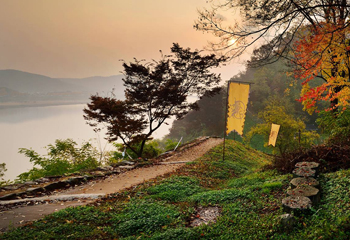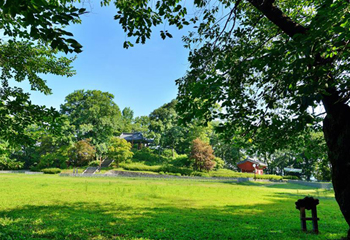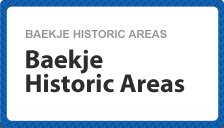Gongsanseong Fortress
Gongsanseong Fortress was called Ungjinseong, serving the royal palace of the Baekje Kingdom for the sixty-four years of the Ungjin Period (475-538 CE). This mountain fortress occupied 20ha area cross administrative district of Geumseong-dong and Sanseong-dong of Gongju. Gongsan Mountain is connected with downtown Gongju to the south and the Geumgang River to the north. Outer side of Gongsan Mountains, except in the southeastern part, form cliffs, providing optimal geographical conditions for natural fortification. Gongsanseong Fortress was built for a royal palace and a defensive facility in utilizing the natural topography and mountain peaks connected to each other across valleys. Important facilities, including the royal palace, were built within the fortress.
From 1980, archaeological excavations were conducted, revealing the construction styles of the fortress rampart, the royal palace site, and the ancillary structures of the royal palace.
Fortress Walls

Gongsanseong Fortress consists of both earthen wall sections and stone wall sections, although most parts are stone walls. The total length of the fortress amounts for 2,660m (stone walls: 1,925m; earthen walls: 735m). Earthen ramparts are found in outer and inner walls to the east section, and the outer wall area has kept its original appearance of the Baekje Period. Most of the stone walls were built during the Joseon (1392-1910), the lower parts of the stone walls were partially constructed during the Baekje Period. The current state of the fortress shows both the earthen ramparts built during the Baekje Period and stone ramparts partially reconstructed afterward. After the downfall of Baekje, the fortress ramparts of Gongsanseong Fortress were reconstructed and rebuilt as stone walls.
Royal Palace Site

Two mountain peaks (110m high) are located within Gongsanseong Fortress, with the royal palace placed in a wide area (7,000m2) on the summit of the western peak. The western peak commands a fine view of downtown Gongju, the Geumgang River, and the Tomb of King Muryeong and Royal Tombs, Gongju. An excavation conducted in 1985 had discovered archaeological remains, most of which were building sites and ancillary facility sites dating to Ungjin Period. Among the major archaeological remains are a number of sites once occupied by a large building with stud walls (35m east to west, 10m south to north), several buildings with columns implanted in the ground, and a pond for the local water supply. Diverse archaeological findings, including roof tiles, bronze mirrors, and earthenware items, have also been discovered at this site.
Archaeological Site of Seonganmaeul Inside Gongsanseong Fortress
The archaeological site of Seonganmaeul measures approximately 40,000m2 in the site, and is composed of remains of ancillary facilities of the royal palace. The ancillary facilities of the royal palace were placed on the wide flat land within the fortress. The excavation began in 2005 and additional excavations on occupation layer of Baekje were conducted in 2011 and 2012. The areas containing Baekje archaeological findings account for about 6,300m2. The occupation layer of Baekje lies between four and seven meters below ground, while archaeological remains dating back to the Unified Silla are in the above layers. A total of fifteen building sites, embankments, sites of stairs, roads, water storage facilities and a drainage system were identified among the archaeological site of Seonganmaeul. The site utilized natural topography, where embankment were found inside the building site. The unearthed building sites were occupied by two buildings with platforms, large buildings with stud walls, and buildings with columns implanted in the ground. All of these are considered to be remains of ancillary facilities of the royal palace.
The water storage facilities were unearthed at archaeological site of Seonganmaeul. Only half of them were examined to be dated and the archaeological findings discovered in these facilities contain a suit of lacquered leather armor, an iron armor, a horse armor, and long swords. The lacquered leather armor boasts a very splendid appearance. Its condition at the time of excavation was good enough to enable researchers to determine its original appearance. Some parts of the armor bear Chinese characters written lengthwise in red. These characters include information about a specific date, the 21st day of the fourth lunar month in the 19th Zhenguan Year (645 CE). The lacquer used on this armor was made of sap collected from Dendropanax morbifera in Baekje. Some ancient documents of Korea and China mentioned that Baekje exported armor called myeonggwanggae to the Tang Dynasty in China. Thus this particular lacquered leather armor could be an actual example that previously known in historical records. This is direct evidence of cultural exchanges between Baekje and China before they waged.
Other Archaeological Sites inside the Fortress
Important archeological discoveries were found in the flatland near the west Gate and northern slope of the royal palace site, which include building sites, water storage facilities and pond spaning the periods from unified Silla to the Joseon Dynasty.










